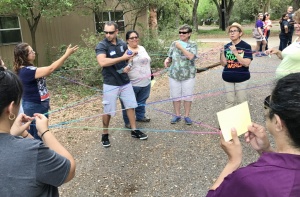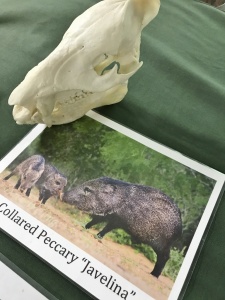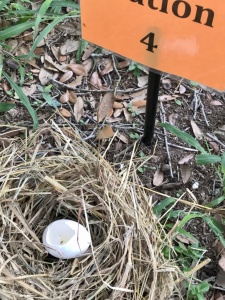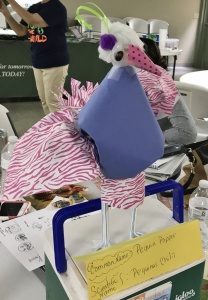Teacher Workshops aren’t just for school teachers.
Three RGVCTMN members attended a recent Texas Wildlife Association L.A.N.D.S. Outreach Teacher Workshop held at Estero Llano Grande. Other Valley venues held this training, too. The instructor was Elisa Velador, the RGV Region TWA Educator — who also happens to be a new chapter member.
L.A.N.D.S. stands for Learning Across New Dimensions of Science.
If you missed the fun L.A.N.D.S. workshops, there’s an upcoming Texas Parks and Wildlife Department, Project WILD workshop just announced via our chapter ListServ.
I don’t mean to infer that the TPWD workshop will be like the L.A.N.D.S. workshop, but it sounds like a similar opportunity for adults to have fun with projects while learning some neat things to present to groups of children.
Here’s a brief synopsis of projects we experienced at the L.A.N.D.S. workshop.
The main idea is hands-on activities to engage children while hoping they learn some of the tenets of habitat that we hold so dear, as Texas Master Naturalists.
A couple of the exercises could even make for fun ice-breakers before beginning a workshop for adults.
The term, Food Chain is passé — it’s now Web of Life. This interactive project shows how it all works together. Everyone is handed a card labeled with the words: plant, insect, herbivore, omnivore, or carnivore. The person in the middle of the circle is either sun, or bacteria. The ball of yarn is tossed around to show how organisms use energy and bacteria and the inter-connectedness of it all.

The day was filled with group exercises. After a brief session that talked about incisors, nasal canals, eyes forward or side, and auditory balls, each group was handed a skull for identification.
Omnivores, such as javelinas, have it all, teeth-wise, allowing them to eat plants to prey and even grub in the earth. They have a long nasal cavity which gives them a very good sense of smell helping them find underground roots and bulbs. They also eat flowers, fruit, nuts, cacti, grubs, reptiles, eggs and mesquite beans.


A little jingle helps with clues as to eye sockets: “Eyes to the side, I hide; eyes to front, I hunt.” The eye sockets of the coyote, a predator, are to the front, allowing both eyes to focus and tell distance — helpful for animals that rely on prey for food. Coyotes eat mice, squirrels, rabbits and other small mammals, birds, snakes, lizards, insects and frogs.

CSI – Nest Predation. This was fun. Six nests were set up with egg shells in different arrays. Each depicted the remnants as to how different animals would leave evidence of raiding a ground nest, such as with quail. A clue — raccoons are messy, as evidenced at Station 3. Coyotes and fox, relatively neat eaters, station 4.


Station 6 was an empty nest — as a snake would leave it — no evidence is the evidence!
Toward the end of the day, which went very quickly, for a six-hour gig, each group invented its own bird, named it and described its habits.

Our group invented the Pequin Popper, Pequinus Chilii. Its habitat is the understory of trees. It has a seed-eater’s beak, eats seeds, chili pequin, and plant drupes, fruits and berries. It has long legs and strong feet. It demonstrates an artful mating dance, flashing its colorful wings and tail. Its defense from predators is to run away to eat another day!
If you deleted your ListServ notice for the TPWD Project WILD professional development workshop, for educators of all sorts, check out www.tpwd.gov/calendar under Project WILD.

Leave a Reply